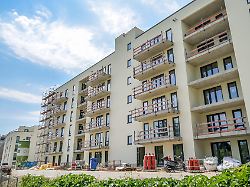Purchase prices, on the other hand, fall
Rents in German cities are going through the roof
February 4, 2024, 10:51 a.m
Listen to article
This audio version was artificially generated. More info | Send feedback
It is often heard that many Germans are increasingly moving back to the countryside. But metropolises in particular are currently booming. This is what current rental prices show. They are increasing massively, especially in Berlin and Leipzig. The demand is there, but the supply is becoming increasingly scarce.
Enormous demand for living space, stalled new construction and tenants in a cost trap: the pressure on the housing market in German cities has increased significantly. In the second half of 2023, asking rents in Berlin, Hamburg, Munich, Cologne, Frankfurt, Düsseldorf, Stuttgart and Leipzig rose by an average of 8.2 percent compared to the same period last year, as an analysis by real estate specialist Jones Lang LaSalle (JLL) shows. That was significantly more than a year before (6.3 percent) and on average over five years (5 percent). The experts see no end to the upward pressure.
For the study, around 35,000 rental and 41,000 purchase advertisements for new and existing buildings were evaluated. Asking rents do not mean deals. Sometimes the agreed rent differs, but less often than when buying a property.
Rents outside major cities are rising more slowly
The increase in asking rents was particularly strong in Berlin and Leipzig, with double-digit percentage rates. In the capital, JLL even saw a jump of a good 21 percent. In the other metropolises, the increases were lower at rates between 5 and 7 percent. Experts have been observing a sharp increase in rents in Berlin for a long time and point to the strong immigration. With the most recently advertised rents averaging 19.42 euros per square meter per month, the capital is approaching Munich (22.50 euros) as the most expensive German city, wrote JLL.
Overall, the dynamics in the metropolises were stronger than in independent cities: there, the asking rents rose by 4.8 percent within twelve months. In the districts they rose by 5.5 percent.
Given the housing shortage, the increase is not surprising, said author Sören Gröbel. The result is that the gap between existing and new contract rents is growing, which is deterring tenants from moving. “This creates a kind of vicious circle: as rents rise sharply, the number of advertised rental offers shrinks and further exacerbates the tense situation on the housing markets.”
The pressure on the housing market is also increasing because new construction is in crisis due to increased interest rates and material prices. The federal government is a long way from its goal of 400,000 new apartments every year. The IFO Institute expects that only 225,000 apartments will be completed in 2024 – after an estimated 270,000 last year. Excess demand is growing, particularly in the rental markets, said Gröbel. “As a result, asking rents will continue to rise.”
Decline in property prices continues
Meanwhile, the decline in purchase prices for apartments accelerated, as the JLL analysis shows. The asking prices for new buildings and existing apartments in major cities fell by an average of 7.4 percent in the second half of the year compared to the same period last year. A year earlier the minus was 1.6 percent. Most recently, prices for existing properties fell more sharply at 8.1 percent than for new apartments (2.3 percent). Offer prices do not provide any precise information about the actual purchase price – as negotiations between buyers and sellers are common.
According to JLL, the recent low transaction numbers on the real estate market indicate that the price expectations of buyers and sellers are still far apart. In view of the increased loan interest rates, the overall ratio of rental to purchase costs remains shifted in favor of tenants, “which is likely to lead to an additional surge in demand on the rental housing markets for some time.”
